The Fall 2008 Anime Preview Guide
Carlo Santos
by Carlo Santos,
Carlo is an engineer by trade, which doesn't really have anything to do with anime and manga, except for the part that involves obsessing over minute details and memorizing lots of useless information. He can most often be found curled up with the latest manga releases in America as he works on his biweekly manga column. When not consuming various forms of Japanese entertainment, he can also be found parked in front of the PS3 enjoying the latest in "next-gen gaming" (whatever that means these days), or at the piano playing the hits of Mozart, Chopin, and Berryz Kobo. Thankfully, his apartment is not nearly as messy as Nodame's.
Michiko to Hatchin

Rating: 3.5 (of 5)
Review:
It begins like the average "dark" anime: a dark lady breaks out of a dark prison, fends off the authorities that are after her, and speeds away into the dark night. Then the opening music starts, and you know you're in for something entirely different.
Maybe a little too different, though: right after the opening credits, we get 15 minutes about some poor adopted girl named Hana who is completely abused and traumatized by her family. Hey, what happened to the stylish action-adventure that the opening sequence promised? When the lady from the start of the episode finally comes barging in and spirits Hana away, that's when the good stuff starts—but unfortunately an entire episode has already gone by. So it remains to see if the promise will be fulfilled.
That ill-advised 15-minute stretch is good for a couple of things, though: first, it gets the viewer emotionally involved in Hana's terrible mistreatment, so that when she finally snaps and breaks free, it's impossible not to root for her. Then there's the unique, sun-baked South American setting, a testament to the imaginative talents of studio Manglobe (Ergo Proxy, Samurai Champloo). Honestly, the only way they could fail at animation is if they started drawing with their non-dominant hands.
Plenty more fail-proof animation abounds, from the expressive, caricature-like character designs, to the vivid colors and details, to the eye-catching action scenes (of which there are sadly too few). And of course, when you've got the director of Cowboy Bebop doing music production, one can only expect the finest aural experience—this time with a Latin American twist. So give Michiko to Hatchin points for style, which it beats just about everything else at, but hold the verdict on the substance, which is yet to develop.
Mouryou no Hako

Rating: 4.5 (of 5)
Review:
Mouryou no Hako's first episode is 15-20 minutes of the most heart-achingly beautiful yuri ever animated, bookended by some ... other things, like plot developments. Yes, those developments are probably the important part going forward—a decapitated head in a box in the first scene, a creepy doll that shows up midway, a tragedy that destroys a friendship in the finale—but the stuff in the middle is what will stick long afterward.
Episode 1 is a tale of two high schoolers, the kind that's often told but rarely this well: in postwar Japan, simple country girl Yoriko becomes infatuated with her refined and beautiful classmate Kanako, forming a tight, almost mystical friendship. Funny how such a simple plot point can be expressed with so much gracefulness and longing, from the languid conversations between the two, to the dreamy colors and filters that wash over every scene (take special note of the moonlight waltz; that's how you do romance, people). Oh, and the pitch-perfect piano and orchestra scoring makes it even more emotionally moving—if there's a soundtrack of the year, this is probably it.
Of course, this all gets a bit froo-froo the more it's allowed to develop—it feels a lot like trying to be pretty for the sake of being pretty (the character designs by CLAMP say hello). So maybe we should be glad for those plot developments cutting in, even if they do result in the overall story feeling a bit disjointed and cryptic so far. Still, being as beautifully produced as it is, the prospect of more can only be a good thing. It's not everyday that a single episode annihilates the likes of Kashimashi, Strawberry Panic, Simoun, and still has more story to tell ... in a completely different genre. Now that's something worth getting excited about.
Skip Beat!

Rating: 2.5 (of 5)
Review:
Skip Beat!: the anime whose premiere episode probably should have been played in reverse. It begins with all manner of forehead-slapping clichés, hits a sharp emotional turnaround about 16 minutes in, and then reveals the brilliant hook at the end. Which is all fine and good ... except that you've already scared off skeptical viewers thanks to the first several minutes. And who could blame them? The story begins with humble Kyoko Mogami, who wears herself out working day after day to scrape a living in Tokyo. But there's a reason: Kyoko is rooming with her childhood friend Sho Fuwa, who is pursuing his dream to become a teen idol. Right from the start, it just offers too many reasons to hit the stop button: the irritatingly submissive girl who can't stand up for herself, the jerk of a hot guy that she's clinging on to, the vapid celeb-worshipping Tokyoites, even the ideal that being attractive and famous is all there is to live for.
Then it gets good ... but "then" comes a little too late. A stirring flashback (punctuated by the only good background music in the entire episode) finally explains how Kyoko and Sho's living arrangement came about, after which Sho reveals his true colors, Kyoko goes nuts, and finally reveals that she's a strong-willed heroine worth rooting for after all. Not surprisingly, much of this happens with exaggerated comedic imagery—the opening of Kyoko's "Pandora's Box" is disturbingly fun to watch—and the crisp lines and bold colors add an extra layer of polish to the visuals. At the same time, though, it's clearly bound by the constraints of its urban Tokyo setting, as well as the stereotypical character designs. With that kind of mainstream leaning, the only thing that can really be said is "People who like the kind of stuff Skip Beat! is about are probably going to like Skip Beat!." Whatever that means.
Tytania

Rating: 2.5 (of 5)
Review:
The industry understands your concerns about the glut of shiny, fluffy, sissy-boy anime with dozens of mewling girls in them. That's why we have Tytania, the most audacious outpouring of barrel-chested testosterone this side of Legend of Galactic Heroes. It is so flooded with manly men, in fact, that they had to insert a token "here's a cute little girl" scene just to confirm that we had not entered some kind of freaky monosexual universe where humans reproduce by mitosis.
The series itself, however, doesn't seem too promising, being stuck in a traditionalist time machine. It begins with a heavy dose of starship porn, after which we are introduced to the Tytania clan—a royal family that rules the galaxy with an iron fist. After these virile men demonstrate their might with some vigilante justice, the scene shifts over to outer space where the commander of the Tytania fleet takes on the technologically advanced upstart nation of Euria. Guess which nation has thousands more ships with which to annihilate his foe? And guess which nation embarrasses his opponent by using sneaky, clever tactics to fool the galactic Goliath? As visual entertainment, this episode is surprisingly ineffective—most of it involves overdressed officers and nobles standing around discussing military and political strategy. Maybe this is exactly how it played out in the novels, but honestly, it looks like the animators tried to cheap out by having as many talking-head scenes as possible. Add in the usual cadre of impossibly huge, CGI-rendered spacecraft and the whole thing just looks like everything else ... that aired in the 70's and 80's.
But they definitely weren't kidding about the "space opera" part, as proven by the Wagnerian opening song and the ridiculously brassy and dramatic soundtrack. Between the over-the-top music and the elaborate set design—fancy starships, fancier uniforms—it's clear that everyone wanted to make this look like a Big Deal. However, it's hard to see what the big deal is about a stodgy, old-fashioned space battle anime.
Kurozuka
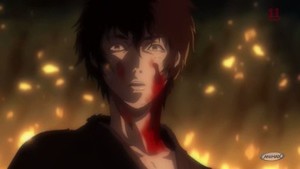
Rating: 4.5 (of 5)
Review:
There are times in every fan's life when they must ask themselves: Why do I watch anime? Studio Madhouse answers that with this stunning historical tale that gets just about everything right. Opening with action-packed badassery, closing with badassery, and stringing the two together with quietly intense drama in the middle, this is an easy contender for best of the season ... if only we could find out what happens in the rest of the story. Yes, it would be easy to criticize this one as "it's slow," but what a rich and gorgeous slowness it is. The tale opens with young warrior Kuro and famous historical monk Benkei on the run from enemy soldiers, engaging in some spectacular combat scenes before finding refuge in the woods. While navigating the forest, they come upon a house occupied by a single young woman named Kuromitsu, who lets them stay a few nights under one condition: they must not peek at whatever's hidden in her personal chambers. But Kuro, poor fool, lets his curiosity get the better of him ...
When it's not busy blowing your mind with blood-soaked swordfights, flaming arrows and time-dilation special effects, this episode finds other ways to impress, most notably with the vivid imagery. Character designs and costumes are meticulously drawn, richly colored backgrounds help to set a wide range of moods, and everything just flows from one scene to the next. You thought Madhouse did a good job when they worked on Death Note? This stuff makes Death Note look like Shin-chan. A folk music-laced soundtrack also embellishes the action scenes, making this one of the most complete packages of animation to be made in a single episode. The very idea that there are, in fact, more episodes to come just makes me collapse from the sheer awesome.
Kannagi (Episode 2)

Rating: 4 (of 5)
Review:
In the future, animation students in Japan will be forced to study episodes of Kannagi. Or at least they ought to, as the series' high point continues to be its lively, perfectly nuanced character animation. Whether it's an outwardly funny scene like resident goddess Nagi waving her plastic magical-girl wand at an evil spirit, or something as tender as holding a pair of stray kittens, each moment is all about bringing the characters to vivid life. What's also impressive is just how much story is covered in this episode: now that he's awakened Nagi, hapless schoolboy Jin must deal with her various whims and mishaps, like when she accidentally superglues her broken wand to the living room table, insists on taking care of the kittens she found, and later—in a fit of anger—stalks off to do some purifying magic on her own and makes a rightful mess of it. It's also here that we're introduced to Tsugumi (the "girl on the phone" from Episode 1), Jin's childhood friend, who completely misunderstands why Nagi is living with him until the goddess puts on the acting performance of her life.
What makes this style of comedy so enjoyable is the balance between extremes—for every slapstick action, there is an equal and opposite subtle reaction. And those subtleties are truly one of a kind: Nagi's penchant for convenience food, for example (ironic that a tree spirit should love the taste of artificial flavors and preservatives), or the oddly disenchanted kids in the final scene staring into the sunset. Speaking of sunsets, the background work finally starts to show promise here, especially with the late afternoon colors over Jin's hometown and his backyard. A gentle, slightly offbeat soundtrack laid over the episode also adds to the atmosphere. Few comedies manage to be wacky while still achieving a calming slice-of-life mood, but this one does, and that is what sets Kannagi apart.
Hakushaku To Yousei (Earl and Fairy)

Rating: 1.5 (of 5)
Review:
We've expelled plenty of hot air discussing stuff that panders to fanboys. Now it is time to address an equally pernicious species of anime: the kind that panders to fangirls! Let's look at the title of this, shall we? It has the word "fairy" in it. You know, because girls LOOOOOVE things involving fairies. What else do girls love? How about 19th-century England, long frilly dresses, talking cats, and bishounen of questionable moral fiber? You like that, huh, don't you, easily-pandered-to fangirls? Also, important marketing research shows that girls apparently prefer the static imagery of manga and novels over anime, which would explain the slideshow-like animation where 80% of the scenes involve talking heads facing directly forward. Ironically, this visual technique resembles dating-sim games more closely than actual dating-sim anime adaptations do. But hey, everything looks really pretty and sparkly, right? And forget trying to set the mood with any 19th-century-sounding music, because we can just play whatever as long as there's a pretty boy on screen!
Meanwhile, this episode is so busy trotting out the fujoshi fodder that by the time any actual plot shows up, they have to start playing the ending song because they were out of running time. When it's that bad, do you really care what the story is anymore? For what it's worth, it's about a certain Lydia Carlton who goes by the profession of "fairy doctor," and gets spirited away aboard a luxury ship by the mysterious and handsome Earl Edgar von Lichtenstein (or something), because he's the descendant of the first Earl of the Fairy Nation. Wow, people were on some serious drugs in the 19th century. And other people must also have been on some serious drugs to churn out this dreck and think they could pass it off as a watchable series. As far as 19th-century-themed anime goes this season, Kuroshitsuji is the Kentucky Derby, while Hakushaku to Yousei is Barbie Horse Adventure.
To Aru Majutsu no Index (Episode 2)

Rating: 2.5 (of 5)
Review:
Oh, Magical Index! You turned exactly into the thing I was hoping you wouldn't turn into: a whack 'em smack 'em supernatural fight show with an arbitrary villain of the week. After discovering that a terrible accident has befallen little magical nun-girl Index, our hero Touma finds himself face-to-face with a cigarette-smoking, trenchcoat-wearing fire-user. OH, SO ORIGINAL ... if they hadn't already done that in about 4,753 other series. The two of them engage in combat, which takes up an entire two-thirds of the episode, and Touma finally figures out how to beat the guy when Index's eyes glaze over and she starts spouting vital facts from the thousands of magic books she's memorized (another overdone gimmick). After the fight, Touma tries to get Index some medical help by dropping her off at his babyfaced teacher's house—pretty much the only time we get a spot of comedy and learn more about another character. Naturally, the episode ends with an obligatory ominous-person-standing-on-a-pole-in-the-moonlight pose, in case you needed a reminder that this has fallen smack-dab into generic territory.
Spectacular visual effects are pretty much the only thing carrying this episode, especially with all the manifestations of flame surrounding Touma in battle. Character movement and animation also shine, as evidenced by the casting of the first fireball, the moment Touma punches out his enemy, and everything in between. The ambient electronic music would have probably made a stronger impression, too, if it weren't for all the loud explosions drowning them out.
Sadly, all the things that made the first episode seem more promising than others of its kind—Index's lively personality, the sci-fi edge of Touma's home city—are all but gone. For goodness sakes, Index spends most of the episode lying on the floor. There's the off-chance that later episodes will improve, but this one is on pretty short notice right now. Get better or else.
Kemeko DX (Episode 2)

Rating: 2.5 (of 5)
Review:
Kemeko DX may be deficient in a lot of things, but framerate is not one of them. As if to prove that Episode 1 wasn't just a fluke, this next round of boy-meets-alien madness also comes packed with super-smooth animated sequences, from a little girl going bonkers with a frying pan to an epic mid-air rescue scene. Never mind that the art and design aspects are very juvenile-looking, just look at those lines flow! And if they can't afford to animate everything in Slick-o-Vision, there's always other ways of getting creative: an extended sequence where the hilarity happens through off-screen sound effects, a clever little reference to Sayonara Zetsubou Sensei, or (gasp!) even having a character say a hilarious one-liner. Add in the world's most politically incorrect theme songs and this series continues to lead the way in non-sequitur humor.
Those brilliant strokes of comedy don't come until the second half of the episode, however, and the attempt at story-building in the first half is pretty lackluster: we're introduced to Tamako, the hardworking little sister of reluctant hero Sanpeita, and in the meantime Sanpeita continues trying to figure out the mystery of the alien girl who crash-landed in his bedroom. She claims that she's not the childhood friend Sanpeita thinks she is, and then explains that she's here to fight a terrible enemy: the multinational electronics corporation headquartered in Sanpeita's hometown. Of course, nobody really cares about any of this, because quite frankly, things don't get good until Tamako catches Sanpeita "in bed" with his new alien friend and all hell breaks loose.
If points could be given just for fluid animation and being completely nuts, this would be a winner—but Kemeko DX's second episode misplays it by letting a full 12 minutes drag along before the real hilarity starts.
Casshern Sins (Episode 2)

Rating: 3.5 (of 5)
Review:
Sad robots crying in snow! Okay, no snow, but still the sad robots. The continuing adventures of Casshern take an even bleaker turn in this episode as he stumbles upon a community of androids quietly waiting for "ruin"—in other words, the mechanical equivalent of death, as the apocalypse has left them no way to repair themselves. Heck, they even include a young robot couple, just for super tear-jerking Kleenex effect. But as soon as they find out who he really is, things quickly deteriorate: the rumor going around is that those who devour Casshern will stop the ruin, and when everyone starts threatening him, he goes into killing-machine mode again ... thereby causing more death wherever he goes.
Like the one before it, this episode is still smugly holding back information—sorry, but "everyone wants to kill Casshern because a rumor said so" doesn't cut it—and offers an episodic self-contained story instead of digging fully into the central plot. At least the pink-haired girl in the earlier part of the episode kind of tried to explain what the deal was surrounding Casshern ... wait, no, she really didn't. So those looking for something to appreciate will have to appreciate it for the sad dying robots. But wait—the artistry and production are worth appreciating as well, with the rich, textured backgrounds (how many anime do you see where they actually make an effort with the backgrounds?), the intense action sequences, and the quietly gorgeous music that undercuts many of the dramatic scenes in this episode. The careful use of soft-filter around the linework also adds an unexpected level of subtlety, making this the sci-fi anime that looks quite different from sci-fi anime.
While it may be the polar opposite of Gurren Lagann in terms of tone and theme, there's no doubt that if Casshern Sins doesn't stir some deep-rooted emotions, you might be a soulless robot yourself.
CHAOS;HEAD
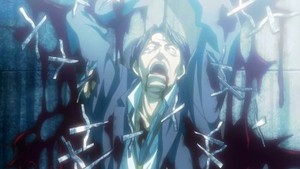
Rating: 3 (of 5)
Review:
That's it, visual novel adaptations. You have gone too far. The main character is an unabashed otaku (living in a shipping container on the roof of a building, no less), he has an imaginary anime girlfriend, he makes references about how the events surrounding him resemble an ero-game, and the last scene in the episode says "Do you want to save?". Of course, this is all done tongue-in-cheek, but it's still really blatant and annoying, and gets in the way of an intriguing psychological-horror story.
The good part of the episode involves a string of gruesome serial killings in the Shibuya area, which reaches the attention of main character Takumi after he hears about it on the Internet. Naturally, Takumi is too detached from society to care ... until he passes through a dark alley on the way home and runs into a blood-covered high school girl who's just stabbed a man to death with dozens of little daggers. For whatever reason, he picks up one of the daggers, takes it back to his place, and then starts freaking out.
Takumi's growing sense of paranoia—if a little overblown—is what really works in this episode's favor; not only is he constantly second-guessing himself and losing a grip on the border between dreams and reality, but the well-written music and artistically striking scenes of gore and violence also help to set the mood. Unfortunately, this mood keeps getting derailed by obligatory fluff like a visit from Takumi's sister, a prim-and-proper girl who inexplicably takes an interest in him and his hobbies, and his constant delusions about his anime girlfriend. With the story incongruously ricocheting back and forth like that, even viewers might be left with chaos in their heads.
Hyakko (Episode 2)
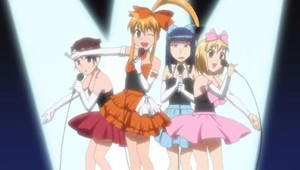
Rating: 3 (of 5)
Review:
Guess what happens in this episode! If you guessed "The four main girls are all killed off by a sword-wielding maniac," not only are you woefully wrong, but maybe comedy anime isn't for you. Those who guessed that the characters get into more humorous scrapes at school would be correct, though, and while the series remains thoroughly unexceptional, there's still enough wit and well-timed humor to keep it from being, let's say, Macademi Wasshoi. This time around our young heroines try their hand at joining various school clubs, with predictably goofy results. Torako gets all gung-ho about signing up for baseball, tennis, basketball, soccer, tea ceremony, calligraphy, flower-arranging ... while Tatsuki remains cynically detached, resulting in a clash of personalities that the quieter Ayumi and Suzume prefer to watch from the sidelines.
The sports club tryouts are the highlight of this episode, with Torako's boundless energy leading the way (including a number of puns on famous athlete names) and always culminating in classic slapstick violence. While the animation isn't the most technically accomplished, there are still plenty of other ways to make it visually entertaining, from the bright colors to the ever-changing character faces to the quick-cut pacing. Some of the best moments are the visual gags that come out of nowhere: the girls envisioning how they might be portrayed as "The Good Ol' Friendly Four", for example, or how Torako and Tatsuki always manage to cancel out each other's shots in basketball.
But while the two strongest personalities in the cast get plenty of attention, this leaves Ayumi and Suzume to languish in the shadows, and the lack of an ongoing storyline might be the big thing that'll keep people from wanting to continue with the series. Then again, if you cared enough to watch the second episode of this, you'll probably keep watching anyway, if only because it's cute and fun.
Nodame Cantabile: Paris Chapter

Rating: 4.5 (of 5)
Review:
There's only one anime in the world that can open with watercolored Paris cityscapes, the strains of Beethoven's "Eroica" Symphony, an an opening theme derived from Rachmaninoff's 2nd Piano Concerto—yes, Nodame Cantabile is back, this time following the travails of two mismatched musical geniuses as they seek their fortune in Europe. You have no idea how refreshing this is after seeing 20 straight shows about teenage kids or supernatural powers or teenage kids with supernatural powers. Consistency is the keyword here, as Episode 1 is a fairly straight reading of the manga storyline (one chapter does get repositioned), and it maintains the quirky romantic-comedy tone that Nodame fans know and love.
The Paris arc opens with scatterbrained Megumi "Nodame" Noda and her high-strung love interest Shinichi Chiaki moving into their new apartments. Once the comedy kicks in, the show proves why it's worth watching: Nodame struggles with the language barrier in a restaurant, desperately attempts to learn French from a phrasebook ("Help! Help! I'm being raped!"), and then finds out she can do it much faster by watching French-dubbed anime on her otaku neighbor's TV. It is at once outrageous yet also pointedly slice-of-life—admit it, you know someone (maybe even yourself) who's tried this "train your brain with anime" gimmickry.
Fans of the romantic angle won't find much yet, however, as Nodame and Chiaki spend more time meeting their new neighbors Franck (the otaku) and Tanya (the slut) than with each other. Music connoisseurs will have to wait as well—the only performance is a scene that Chiaki imagines to himself—although it's worth noting that the horrid instrument CGI from the original series isn't quite as awkward this time. Then again, flashy animation technique isn't that big a deal in a music anime: the visuals are more about stylish design, from the expressively-lined characters to the pastel colors to the vintage European setting. If that sounds about right, then welcome home to Paris.
Clannad After Story (Episode 2)

Rating: 4 (of 5)
Review:
I don't know what kind of mind readers they have at Kyoto Animation, but after showcasing one of my favorite sports in Clannad After Story's first episode, they promptly do an entire episode on my favorite character, Youhei Sunohara! The bumbling blond is in a spot of trouble this time as his little sister, Mei, is concerned about his prospects after graduation. Tomoya and Nagisa's suggestion: if he could show Mei that he has a girlfriend, at least it'd make Sunohara look more stable and responsible. (And this is why you should never take advice from high schoolers.) The result is a run of entertaining sitcom scenes where Sunohara asks just about everyone in Tomoya's circle of friends if they would be his "fake girlfriend." The results are predictable, but energetic and fun nonetheless: Ryou breaks down in tears, Kyou beats him up for making her sister cry, Tomoyo beats him up some more, Kotomi actually agrees but then subjects everyone to her ear-shattering violin playing, and Yukine—bless her, the poor secondary character—is currently occupied with guy issues.
Finally, Nagisa's mom agrees to lend Sunohara a hand, which is a brand of comedy all its own: he thinks she's Nagisa's older sister, and his flustered behavior around her is as screwball as they come. Indeed, it's not the girls who make this episode shine, but Sunohara's nuttiness and the detailed animation that goes into it: every pratfall, every outburst, every facial tic—this guy alone is worth watching for the comedy factor (and to hell with that annoyingly vague girl-and-robot-fantasy-world subplot). Aside from that, though, it's Clannad as usual with the soft color schemes, pleasant but repetitive music, and the bland dialogue and pacing that threaten to put everyone to sleep were it not for Sunohara's frequent gymnastics. The relationship and school life aspects may be hit-or-miss, but KyoAni always nails the comedy.
Toradora! (Episode 2)

Rating: 4 (of 5)
Review:
You know how people always try to hook you into a series by saying it gets better? Well, here's some good news: Toradora gets better NOW! With the premise already in place, Episode 2 is a chance for the Ryuuji/Taiga sparks to fly, and do they ever. Apparently the "Palmtop Tiger" has been spending her days at Ryuuji's house, scheming with him on how she can get closer to Ryuuji's best friend Kitamura—but all their time together has got the rest of the class talking. The first half, then, is a parade of snappily-paced comedy, as the two kids dart about trying to avert the misunderstandings regarding their "relationship." It's also a chance for some brilliant acting on part of the lead characters—their back-and-forth exchanges are as biting as ever, but it's Taiga who steals the show when she takes out her frustrations on a light pole.
The second act is more low-key, trotting straight into high school romance territory as Taiga admits her feelings to Kitamura, but the heartfelt background music (admittedly, anyone who can compose for piano decently wins me over) and deliberate pacing make it a genuinely touching scene. The bittersweet finish and the last few words between Taiga and Ryuuji are also sure to make hearts flutter, even if his line about dragons and tigers (and bears? Oh my!) feels somewhat contrived. But that's how the series gets its name, so.
Being the kind of show that it is, there aren't many opportunities to showcase eye-catching animation—but comedy nuggets like Taiga's light pole barrage, getting clocked in the head by a basketball, and even general acts of violence towards Ryuuji (also, what's the deal with his pet budgie?) prove that they're putting in the effort where it counts. And that can go a long way in making an anime great.
Vampire Knight Guilty

Rating: 3 (of 5)
Review:
Vampire Knight Guilty Pleasure begins in amusingly self-referential fashion: with raging fangirls drooling over hot vampire guys. That's right, it's business as usual at Cross Academy, where the bloodsucking members of the Night Class must be escorted by heroine Yuki Cross when they switch sessions with the human Day Class. Helping Yuki with her task is the gloomy, tortured Zero Kiryuu, who is still feeling the emotional aftereffects of a murder he didn't commit (but everyone thinks he did). Completing the love triangle is Night Class student Kaname Kuran, who cares for Yuki just as much as Zero does, and even saved Zero's life in the previous series with a timely blood donation. But can Zero be protected now that the vampire authorities are out to execute him for his alleged crime?
To be honest, Zero should probably be more concerned about his emotional rather than his physical well-being, as the entire episode seems to be one monotonous outpouring of angst. Worse yet, everyone spends so much time talking about past events that the plot barely moves forward—look, I can understand about refreshing the audience's memories, but come on. Yet the storyline so far isn't a total failure: a few moments of comedy (see aforementioned fangirls) help lighten the mood, and the antagonistic tension between Zero and Kaname helps break up the constant self-pity.
A convincingly gothic atmosphere is what lifts this episode above barely average, with the melancholy-sounding music and theme songs, elaborate school uniforms, and period architecture. Attractive, shiny-eyed characters of both genders help too, although the fine folks at Studio DEEN cannot do gesture animation to save their lives. Maybe that's why there's so much standing around and talking after all.
Kemeko DX

Rating: 3 (of 5)
Review:
You'd think that after To-LOVE-Ru, boys would know better than to fall in love with hot pink-haired alien girls. But not Sanpeita, who still can't get over his childhood crush from 10 years ago. Now in high school, Sanpeita's prospects for romance seem poor—until a green-haired midget comes crashing into his house and declares herself to be his bride. It only gets worse when he goes to school the next day: bizarre robot invaders try to attack him, and the midget must step in and fend them off. Only in the aftermath of the battle is the truth revealed: that green thing is actually a spacecraft named Kemeko, and piloting it is the girl Sanpeita fell in love with years ago!
Explaining one's taste in comedy is a bewilderingly inexact science. But know this: despite the weightless, brainless storyline, despite the unrefined gag-style animation, despite the background music apparently performed by one guy on a Casio keyboard ... this opening episode actually entertains. Maybe it's the unexpectedly sharp punchlines, like when the alien girl leaps out of her sickbed and spontaneously bleeds. Or the over-the-top sci-fi action sequences that are actually done really well—when Kemeko battles the evil robot creatures, you can pretty much see where all the animation budget went (as well as the music production). Maybe it's even that weird closing song with all the Freudian references; in fact, the fanservice and sexual deviancy of the series is so off-the-wall that any feelings of idiocy or perversion are completely waylaid by the sheer absurdity.
So: Pointless story. Predictably loud and wacky characters. Animation done on the cheap. And yet, like Ramen Fighter Miki from a couple of years back, Kemeko DX ends up being more amusing than it probably deserves to be.
Yozakura Quartet
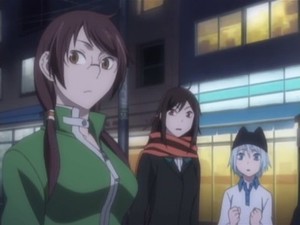
Rating: 2.5 (of 5)
Review:
Well, we seem to have survived the initial wave of boy-meets-girl anime and are now deep in I've-got-powers-and-I'm-not-afraid-to-use-them territory. So far, Yozakura Quartet plays it very conventional, with its teenage protagonists, suburban setting, and obligatory villain of the week. At least the opening narration tries to explain what the deal is with all the special powers: the town of Sakurashin was built as a gateway between the youkai and human worlds, so it's only natural to have magic and spiritualism in the area. The stars of the show include Hime, who is blessed with incredible agility (so she can do the dramatic standing-on-a-pole pose); Ao, who under her cat-eared hat has the ability to read minds; Kotoha, who can conjure any object from the words she says, and one very normal boy, Akina. Their mission in this episode is to stop a gun-toting escaped criminal—which ultimately comes down to outsmarting him with their powers.
It should come as no surprise that the final fight scene is the bread and butter of this episode, bristling with energy as the girls show off their powers in dramatic fashion—Hime's bullet deflection is particularly impressive. Unfortunately, it also means the rest of the episode pales in comparison (and take that literally as well; what's with the faded color palette?). Most of the running time is taken up by a dialogue-laden snoozefest where the kids discuss other issues concerning their town and daily life, and while some might enjoy this laid-back "high school kids hanging out" atmosphere, personally, they couldn't have picked a better way to make me uninterested in any further adventures.
Right now, the sense of style is the best thing the show's got going for it: the characters dress like actual normal teenagers, the rock-infused soundtrack gives it a modern edge, and the ending song is worth a spin just because it's the sweet sounds of Round Table feat. Nino. But when you've got superpowered high schoolers chatting amongst themselves for over half an episode because they're just killing time until the action starts, there's clearly a lot of room for improvement.
Shikabane Hime: Aka

Rating: 4 (of 5)
Review:
Well, after the head-scratching dullness of Ga-Rei Zero, guess what should pop up next on the to-watch list: a series that does the supernatural action genre right! Meet Ouri Kagami, a teenage boy whose defining childhood experience was seeing his older brother re-animate a dead girl as an undead shikabane. Now fast forward to the present day, where a womanizing serial killer lurks the city and is so obsessed with death that he's even turned himself into a shikabane. That's when Makina, the Shikabane Hime ("corpse princess"), steps in to stop this monster with her own undead abilities. In the middle of the fight, however, she accidentally crosses paths with Ouri (who's currently hauling stuff to his new apartment), and his lack of fear towards her suggests he might be involved in more undead business soon...
Where Shikabane Hime: Aka just plain "gets it" is in setting the right kind of drama and intensity. Ouri's childhood flashback, for example, is told through a slightly shaky, grainy filter—a classic horror device right there—and the episode's marquee set-piece is Makina's one-on-one duel against the killer, with its dynamic camerawork and vibrant sense of motion. The animation's not as shiny, smooth or detailed as a top-budget production, but making it feel alive is what gives this one the edge. Moody use of light, color and shade, plus a tense and discordant soundtrack, also add a lot of atmosphere to what would otherwise be a generic "everything is happening at night" affair.
With the setting and the visuals pretty much an instant win, all that remains is for the story to sort itself out. Right now, Ouri's role and the shikabane underworld seem to be sliding off in different directions, and the awkward transitions between these plot threads is the one thing holding the series back. But that's what the remaining episodes are for, and it's certainly slick and stylish enough to keep watching.
Ga-Rei Zero
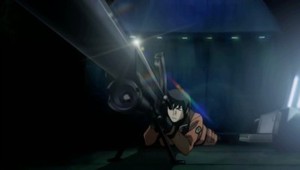
Rating: 2.5 (of 5)
Review:
All right, trying to feel impressed here ... wait for it ... nope, nothing's coming.
Peculiar as it may seem, Ga-Rei Zero is one of those examples where it does everything right on paper—solid story concept, decent set of characters, polished animation and music—but the creative soul of the series never shines through. The premise is easy enough to understand: in modern-day Japan, the Supernatural Disaster Prevention Agency is tasked with keeping the peace when malevolent spirits run wild. However, things have been getting worse lately, and so the elite members of the SDPA's 4th Division find themselves having to get pretty creative about defeating a powerful "Category B" spirit. But just as soon as the job seems done, a greater disaster awaits ...
Sounds like it'd be good, right? Action, supernatural themes, military technobabble—but the first episode just feels so blandly methodical, as if people realized "Oh hey, another spirit-hunting action anime, except everyone wears uniforms and uses modern guns," and then proceeded to go through the motions. And maybe that's the problem: the characters are there, doing their job, but there's no inner drive, no critical event to motivate them. (The leading man does appear to have some past issues involving a girl he once loved, but the back-story is still too vague at this point.) Meanwhile, an attempt to expand on the world of the story with lots of important-looking leaders around a boardroom table just comes off as a contrived dialogue scene where everyone tries to out-jargon each other.
The audiovisual presentation has these problems too: the character designs are polished, but forgettable, there's plenty of technical detail, but nothing about the weaponry stands out, the special effects don't seem all that special (is this the season of sloppy CGI or something?), and the pulsing action-thriller music score—although highly accomplished—sounds like the pulsing action-thriller music score of any Hollywood movie you might run into during the summer. Although it'll certainly find its audience, this feels like the kind of anime you watch because there's nothing else on.
ef – a tale of melodies

Rating: 3.5 (of 5)
Review:
Give the ef series credit for one thing: it sure doesn't look like anything else in its genre. In that respect, a tale of melodies remains perfectly consistent with its predecessor, a tale of memories, employing bold sweeps of color and shading, unexpected camera angles, and an overall aesthetic sensibility that often comes close to surreal. Unfortunately, the narrative style also borders on the surreal, much to the detriment of the episode's first half: a young man named Yû stands around waxing philosophical with his friend Yûko, unless he's waxing philosphical with another buddy of his, Shuichi, or pondering if he wants to participate in art class where a girl is drawing a nude portrait of herself. What is this, a Studio 4°C production? (That's a rhetorical question; I know it's SHAFT.) Understandably, some people eat up this artsy-fartsy stream-of-consciousness shoegazing, but a little sense and logic never hurt anyone.
Thankfully, the second half is more conventional in tone, introducing us to Renji (a key player in the last ef) and his friend Mitsuki, who has taken an interest in next-door neighbor Shuichi. But not in the romantic way, she insists! She just likes his violin playing. The last portion of the episode is where things really start to take off, as Mitsuki meets Shuichi and the two have this languid, drifting conversation about all manner of things—a truly slice-of-life moment. A gentle, minimalist soundtrack punctuates this conversation sequence, revealing the show's unusual beauty when all the elements come together.
But even as it ends on that heartwarming note, I would not blame anyone who gave up on this immediately, throwing their hands into the air and exclaiming that This Is Boring And Nothing Happens. And this is true! The unusual rhythm of the episode, and a certain lack of concreteness or familiarity, make it very much an acquired taste. But love it or hate it, Nothing Happening has never looked so artistically striking.
Tales of the Abyss (Episode 2)

Rating: 2.5 (of 5)
Review:
Has the real adventure started yet? Unfortunately, no; after completing the battle tutorial in Episode 1, the next step for our young hero Luke is to complete a mini-quest. Apparently, his sudden magical teleportation went further than expected, and Luke and the mysterious swordswoman accompanying him have inadvertently hitched a ride straight into enemy territory! After stopping off at a village, Luke and Tear (that's the swordswoman's name, we find out) run into Fon Master Ion, a magician who had been presumed missing. It turns out that Ion was investigating an ecological imbalance involving cheagles—rabbit-like woodland creatures—and it's up to Luke to restore peace to the cheagles' forest.
If this episode could be described in a sentence, it would be: "Luke gets an animal mascot." Yes, that's how weak it is on content, and the only thing that makes the series still worth following is that it ends on a cliffhanger, and the preview for Episode 3 looks a lot more promising, and ... I'm embarrassed to admit this, but Master Ion has the most adorable lisp on the planet. Otherwise, this is RPG fluff at its fluffiest—and that's to be taken in the literal sense as well, considering that this episode runs entirely on cute appeal. Adding a couple of new characters to the party helps a little bit, but honestly, you'd have to be a fan of the game or have a very high tolerance for fantasy-adventure clichés to keep on watching.
At least the strong visuals make it tolerable to sit through; the creature designs are surprisingly appealing (and not just the cheagles), the environments are consistently beautiful, the character costumes show great attention to detail, and the combat/magic scenes—however few there are—are still convincing, if a little conventional. Now if only the story would hurry up and become worthy of the pretty pictures.
Kuroshitsuji
Rating: 4.5 (of 5)
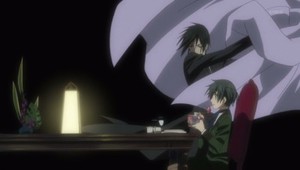
Review:
Ladies and gentlemen, we have a winner! From its lavish atmosphere to its intriguing lead character to its high-class audiovisual presentation, Kuroshitsuji (which translates ominously to "Black Butler") is one of this season's offerings that hits it out of the park. Above all, Episode 1 makes sure to get the setting right: rich Victorian architecture, lovingly detailed period costume (okay, we got a token maid, but her outfit is still closer to Emma than He Is My Master), even antique props like dinnerware and board games. Thrown into this mix is young aristocrat Ciel Phantomhive and his eminently capable butler, Sebastian. And just how capable is he? Well, short of engaging in hand-to-hand combat—leave that for the other butler anime—Sebastian protects Ciel from a crooked business deal by dishing out some homebrewed justice on a visiting merchant.
Although not exactly horror, it's Sebastian's methods in the second half that will elicit a dramatic gasp; this kind of dark, brooding tone fits perfectly with the Victorian-gothic setting. A hint of supernaturalism (see also: intro scene) suggests that there is more to Sebastian's nature, but frankly, you can get away with concealing background information as long as an individual episode, like this one, tells a complete story in itself. High production values also make the mood and setting all the more convincing: a balanced color scheme, sure-handed linework, and a classically-influenced score bookended by a couple of catchy rock songs for the opener and closer. It should be no surprise that production studio A-1 Pictures is also working on the visually delightful Kannagi; while Kuroshitsuji isn't quite as fluidly animated, the show's mid-tempo pace doesn't really call for a high framerate anyway.
Macademi Wasshoi

Rating: 1 (of 5)
Review:
It's a very telling sign when the only decent visuals in an anime are there ones done with Claymation or computer help. And it doesn't get any better from there: Macademi Wasshoi takes two of my personal favorite genres, screwball comedy and magic-school fantasy, and makes a wreck out of both of them. The comedy portion consists mostly of clumsy slapstick and catgirl fetishism, and the magic-school aspect—well, it's mostly window dressing, and not very good dressing at that.
Episode 1 tells of Takuto Hasegawa, an ordinary schoolboy who secretly attends an interdimensional school of magic with his mute cousin Suzuho. Takuto's troubles begin when a summoning spell misfires and he brings into the world an elf/cat/demon/I-don't-know girl who promptly breaks loose and causes chaos at the academy. Luckily, Suzuho has a secret power up her sleeve that allows her to restore some semblance of order—but now Takuto is stuck with taking care of that thing he just summoned. So it's really just more boy-meets-girl fluff, except with a haphazard, poorly paced fantasy premise, plus the assumption that being as loud and annoying as possible is supposed to make people laugh. Presumably, the mix-and-match side characters are meant to be funny as well—a headless wizard who controls an army of robot golems, a leering teacher who keeps a maid as his familiar—but honestly, it looks more like Harry Potter and the Fellowship of the Sith puked all over this series and left them to mop up whatever dregs of genre parody they could find.
The simple, juvenile character designs leave much to be desired, as does the overall look of the show—understandably, it's going for the "gag" style of animation, but that would require the gags to actually work. Instead, the only funny bits are the 20 seconds where it shifts into Claymation, a couple of bursts of physical humor, and the bouncy opening sequence, which seems to promise a delightful, energetic series but instead leaves you with this hyperactive, uncontrollable mess. 'Scuse me while I go watch Potter Puppet Pals.
Kyo no Go no Ni (Today In Class 5-2)

Rating: 2.5 (of 5)
Review:
Ah, fifth grade. That awkward time when boys are still being boys and haven't quite figured out that thing called "girls" (and probably never will) and puberty is right around the corner. Kyo no Go no Ni tries to mine that part of childhood for comedy material, but only strikes gold a couple of times in this opening episode.
One of those times is where lead character Ryouta challenges one of his classmates to bounce a rubber Superball the highest, resulting in one of those classic over-the-top macho showdowns that only prepubescent boys can deliver convincingly. Then there's the air-guitar-with-brooms sequence which, although loud and repetitive and too long by about 3 minutes, is another genuine childhood moment. Unfortunately, the moment the boys start interacting with the girls—like in the umbrella scenario or the somewhat eyebrow-raising loose tooth story—the series turns into a middling school-life affair that looks exactly like every other school-life anime, except that the characters are younger and more poorly drawn.
Oh right, did I mention poorly drawn? Although it's a noble artistic goal to "say more with less," the simple-lined style of this series magnifies every mistake, and there are just too many scenes where the linework gets noticeably sloppy. It reaches the point where you can no longer write it off as a stylistic choice—it's simply bad art. The sudden shifts into super-detailed style (which should tip off Minami-ke fans that this is another Coharu Sakuraba manga adaptation) work to comedic effect once or twice, but applying the same gimmick over and over gets old fast.
Thankfully, this version of the series is not nearly as morally unsettling as the OVA (aside from a suggestive finger-sucking scene), but replacing that ecchi edge with sloppy art and so-so story isn't exactly what one would call an improvement.
To Aru Majutsu no Index

Rating: 3.5 (of 5)
Review:
Okay, we're up to about Anime No. 7 now with the 43 new shows about some guy who meets some girl. At least this one is ambitious in scope (psychic and magic powers! And yes, there is a difference), the characters are reasonably entertaining, and there's enough animation budget to throw around. An eye-popping special effects sequence introduces us to Touma Kamijou, a misfortune-prone lad living in a near future where psychic-powered humans are a fact of life. Kamijou himself may be powerless, but he has his own unusual ability: he can nullify any power used on him.
All this sounds like typical rah-rah-I'll-punch-you-with-my-chi-energy stuff until a girl in strange robes shows up on Kamijou's apartment balcony—and the character-driven humor starts to show itself. The girl introduces herself as Index—so called because she supposedly possesses an index of thousands of magical spellbooks—and is currently on the run from a sinister magical society (aren't they all). Kamijou's disbelief at Index sparks a brilliant back-and-forth conversation scene, going through pointed barbs and clever turns of phrase before culminating in ... nudity. But moving on. A scene depicting Kamijou's school life is less inspired, serving mostly to depict the lavishly drawn sci-fi-shiny city that he lives in, but the episode does end on the right note of cliffhanger-driven tension when Something Happens To Index.
It's odd, because overall, there are certain elements that don't inspire much confidence: the ultra-generic theme songs, the idea of raging ESPers battling each other, the short-tempered girl who has to explain her arcane otherworld to the ordinary schoolboy (quick, name 5 others, it's easy). Yet the execution is strong enough to show promise, with rich, detailed visuals, a modern, electronica-infused soundtrack, and the hope that this raging ESPer battle will be, if nothing else, epic. It's the superpower-action genre done cool, and it might be worth checking out.
Kannagi

Rating: 4 (of 5)
Review:
Well, this is a pleasant surprise! Normally, when a hapless young man accidentally summons a live-in goddess, one's first instinct is to call up Kosuke Fujishima and tell him it's time to deploy the copyright lawyers. But Kannagi is a textbook example of how to dust off an overdone idea and make it fun again. This time our hapless young man is Jin Mikuriya, who carves a female figure into a wood block cut from a sacred tree—and brings out an actual tree-spirit! But this goddess, who calls herself Nagi, is no Belldandy: she goes nuts when she discovers her tree was cut down, thinks she can exorcise impurities with a toy magical-girl wand, decides that taiyaki is better than actual fish, and doesn't quite get the definition of a phone. Jin, meanwhile, is shocked to find that—in his own words—"Even gods go to the toilet."
What makes Kannagi stand out from other boy-meets-übergirl comedies is the perfectly controlled bursts of energy: for every crazy wacky Nagi moment, there is an even funnier deadpan silence where Nagi and Jin look at each other like idiots contemplating the world. That zany, unpredictable rhythm—always darting between fast and slow—is what propels the entire episode forward. You can also thank the terrific character animation for that: every nuance of indignation and hysteria and embarrassment and bliss is captured in motion, even if it's something as minor as Jin sneezing. The laid-back soundtrack (with just a hint of traditional music, to remind us of the series' Shinto roots) is also careful not to draw attention to itself, letting the comedy stand on its own.
The only complaint about this opening episode is how 80% of it takes place inside Jin's house—come on, animation staff, challenge yourselves—and that there's barely a hint of any other characters yet. Oh, and Rosario+Vampire Capu2 had better watch out: this one's got an idol-singer credit sequence too, and unlike Rosario, it has a good anime attached to it.
Tales of the Abyss

Rating: 3 (of 5)
Review:
Sometimes, the best you can hope for in an RPG anime is to at least contain characters and elements from the RPG it's based on. (Am I still bitter about Persona: Trinity Soul? You bet.)
To that end, Tales of the Abyss does the smart thing and sticks close to the usual fantasy-adventure formula. Meet Luke, a hotheaded young noble who's tired of the royal life; luckily (or unluckily) for him, things change dramatically when a mysterious swordswoman comes strolling into the castle and threatens to get revenge on Luke's swordfighting tutor. But just as Luke steps in to stop the fight, a magical force transports him and his adversary into the wilderness, where they must fight off monsters and get back to the capital. Making the return trip turns out to be surprisingly painless, but once they arrive, a fierce battle is already raging ... which is a really bad place to stop the episode, because it's like the adventure has already started, except not.
Still, this episode does what needs to be done: establishing the fantasy world via narration (the opening montage goes by way too fast, but if you're here because you liked the game, you know this stuff already), introducing the characters and hinting at their epic destinies, and getting the storyline started with a spark of conflict. Not that any of this is particularly innovative or well-executed; it's just ... there.
Visual polish is high on this series, with the bright color schemes associated with the Tales franchise and a number of slick swordfights to prove the animation staff's mettle. Character designs are richly detailed too, although one suspects that part of Luke's epic destiny is to find the guy who gave him that ridiculous haircut and strike him down. And while there's the sound of a full orchestra following the characters around, the music isn't afraid to dial down to just a few instruments as well to get the appropriate fantasy mood. This kind of adventure story is as tired and old as they come, but at least they were nice enough to dress it up and make it pretty.
Rosario+Vampire Capu2
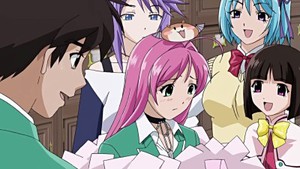
Rating: 2.5 (of 5)
Review:
As defenders against censorship and protectors of artistic integrity, anime enthusiasts must ask themselves: what artistic content do we gain by watching the uncensored, panty-flashing version of Rosario+Vampire Capu2 as opposed to the censored cut? Anyone?
While you're busy trying to B.S. an answer, here's a quick story recap: Tsukune is a schoolboy at macabre Youkai Academy, where all the students are monsters disguised as humans (so they can learn to coexist in the human world). Luckily for Tsukune, all his monster friends take the form of very attractive girls, particularly pink-haired Moka, who becomes a powerful vampire when the crucifix around her neck is removed. The new school year starts for them on a sour note, however, as Moka starts getting threatening notes from a mysterious stranger. After a chaotic opening ceremony, Moka's nemesis reveals herself: a feisty new student claiming to be her sister!
Not surprisingly, people who watched and enjoyed the first Rosario+Vampire will enjoy this one ... which is kind of like saying that people who like cake will enjoy cake. This episode delivers the usual formula of Tsukune-harem flirting, occasional slapstick comedy, and a Moka transformation where she puts unruly monsters in their place. On the plus side, the new girl and the threatening notes add an element of tension, but conversely, this slavish adhesion to formula makes it hard to find any spark or cleverness—this is exactly how every Rosario episode plays out, so why bother watching new ones?
But no one really watches this for the story, right? It's all about that visual flourish invented by Osamu Tezuka himself—the pantyshot, which so completely dominates the episode that viewers might miss the surprisingly vivid colors and competent animation quality. Unfortunately, this panty fixation also results in some really stupid camera angles and awkward transitions. It also explains the rent-a-bishoujo character designs—nobody's looking at the faces anyway because everyone's peeking up their skirts.
For all its bog-standard ecchi-comedy aspects, however, there is one shining moment for this series: the idol-inspired ending sequence with super sugary song to match. So that's what anime looks like when people put in the effort.
Linebarrels of Iron
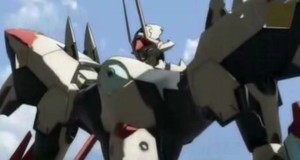
Rating: 2.5 (of 5)
Review:
After all the awed whispers and Internet mutterings and promo material (it's on Crunchyroll! Legally!) about how Linebarrels of Iron is supposed to be the Next Great Gonzo Series, well, one might expect this anime to completely blow one's eyes and ears and mind away.
Sadly, it does not.
What Linebarrels does do is to tell a story that is sure to bore anyone who's heard it before. See, there's this wimpy high school kid called Kouichi who just happens to have a giant robot named the Linebarrel crash on top of him. (Yes, because landing a piece of heavy space machinery in a populated area is such a good idea.) In the aftermath of the crash, Kouichi also discovers a beautiful naked girl and takes her home, because that is what guys do when they find naked girls lying in the dirt. Shortly thereafter, BAD giant robots start attacking the city, and Kouichi discovers that he can summon the Linebarrel by muttering I mustn't run away! I mustn't run away grabbing the breast of the girl he saved earlier. After fighting off the menace, Kouichi realizes that he has become a "hero of justice," while everyone else slaps their foreheads and rolls their eyes at the unbelievable contrivances this story has gone through in one episode alone.
Worse yet, it's not like the visuals are good enough to salvage it—the character designs suffer from deformed-looking foreheads and those annoying cheek-scratch lines, and the robots are all done in state-of-the-art CGI ... from five years ago. It's really unnerving, because it looks so much like it wants to be Gundam Seed or something, yet it doesn't even begin to approach the production values of modern-day Gundam or other marquee giant robot franchises. At least it gets the serious-sounding music score right, but even that's thrown away when the Linebarrel startup sequence kicks off with MEGA TECHNO EUROBEAT. Yikes.
I think many of us wanted Linebarrels of Iron to be impressive. The only thing Episode 1 accomplishes, however, is being impressively generic.
Akane-iro ni Somaru Saka

Rating: 2 (of 5)
Review:
Ooh, you almost had me there, Akane-iro ni Somaru Saka! Opening with a serious military-themed intro scene (which I'm sure becomes Important Stuff later), and then bait-and-switching into a brain-dead high school romance series! Good one!
Sorry to break it to ya, folks, but this is exactly one of those 43 shows that come out every season where some guy meets some girl. This time, "some guy" is Junichi Nagase, and "some girl" is Yuuhi Katagiri, a beautiful heiress whom Junichi saves from bullies one afternoon. And as luck would have it, when Junichi comes into class the next day, he discovers that the cute new transfer student is ... Taiga Aisaka from Toradora! Actually, Taiga would probably be an improvement, because as soon as Yuuhi shows up in Junichi's class, everything plays out to complete predictability: she shows a sudden interest in him, they hang out after school, the whole class starts gossiping, and an unexpected kiss is shared. Oh, were you waiting for something interesting to happen?
No such luck. With the utterly stock characters and a storyline that even an eight-year-old could improve on, the freshest idea so far in this series is the puke-brown school uniforms. (Brilliant color scheme, guys! Let me know the RGB code!) Otherwise, viewers can look forward to dull school activities, dull attempts at comedy, a dull date scene, and most importantly, dull animation and backgrounds. Hey, let's make the characters look as boring as possible, and just for fun, try to avoid having to draw any actual motion or details! The completely mailed-in music score and theme songs add the final touch to this feat of mediocrity, which isn't completely offensively bad—it's just so lacking in creative qualities that you have to ask yourself why anyone would feel like watching past Episode 1. I know I'm not.
Hyakko

Rating: 3 (of 5)
Review:
In a world where "cute girls doing cute things" has been done to death, Hyakko positions itself carefully between reasonably tolerable and not quite as good as the best ones. Our story begins with shy high school student Ayumi Nonomura (played by everyone's favorite Girl of Twenty Voices, Aya Hirano) getting hopelessly lost at her new school. Wandering around the impossibly large but beautiful campus (the palm trees in the courtyard suggest that it is set either in Okinawa or Beverly Hills), Ayumi runs into high-strung Tatsuki—who apparently is just as lost as she is. Several hundred feet later, their excursion is interrupted by energetic Torako and her quiet friend Suzume, and thus all four eventually find their way ... only to get in major trouble after trying to break in through a locked entrance.
Honestly, it would be no surprise if discerning viewers chose to stay away from Hyakko because it rips off everything in sight. Hey Ayumi, Yuno from Hidamari Sketch called, she wants her personality traits back. As for those who want to stick around and see how it turns out, well, the key to comedies like these is that it's all in the delivery—and Episode 1 does deliver a number of gems. The Ayumi-following-Tatsuki sequence set to Vivaldi's "Winter" is brilliant in its tension and development; Torako's explanation of her master plan moves to its own bouncy rhythm; and the attempted break-in is pure slapstick at its finest. (Not to mention Torako's resulting exit strategy...)
Being the kind of show it is, this one doesn't try anything too ambitious visually—the aforementioned comedy gems are really the main moments where the animation stands out. But in addition, the general expressiveness of the characters' faces—despite their rather conventional looks—helps to inject some energy into the proceedings. Finally, it wouldn't be a slice-of-life schoolgirl anime without a laid-back folksy-pop soundtrack. What it all adds up to is a comedy that rubberbands between gentle and quirky and insane—in other words, very much a matter of personal taste.
Casshern Sins

Rating: 3 (of 5)
Review:
Watch out, Lelouch, there's another space-age anorexic bishounen in town! And he wears a skintight bodysuit! Yes, the first thing most people will notice about this remake of the 70's classic is how it proudly wears its retro aesthetic on its polyester sleeves. The swooping, gravity-defying hair, Casshern's super-pointy popped collar, the blocky old-school robot enemies—frankly, the only thing missing is a bass-pounding disco soundtrack, but the dramatic full-orchestra score fills in as a reasonable substitute, capturing the essence of this sci-fi epic.
But is the story epic enough? The opening episode begins with Casshern standing in a barren post-apocalyptic wasteland, beating up angry robots who want to kill him, after which he befriends a cute little android girl, but then scares her off after beating up yet another killer robot before her eyes. So maybe it's not only about man versus machine, but also the struggle between beauty and ugliness. Such philosophical platitudes, however, don't help to fill in what's severely lacking right now: background information, the why and wherefore of Casshern's existence, the events that led up to everyone wanting to kill him. Without all that, well, this runs the danger of being another one of those series where everything looks really pretty but nobody has any clue what's going on.
If you're just in it for pretty things, though, the striking environments and intense action scenes have it covered. Casshern's hand-to-hand combat technique is as slick as they come; the only letdown is that his enemies—the aforementioned blocky old-school robots—are uninteresting, poorly designed brute-force mashers. Two possible improvements that could push this show from decent to great: (1) his enemies get tougher and more creative in their methods, or (2) we learn more about the back-story and get pulled into a dramatic, complex tale of saving the future. I'm really hoping for No. 2.
Clannad After Story

Rating: 3.5 (of 5)
Review:
In a way, Clannad After Story picks up right where the original left off: the soft pastel hues, the hazy, drifting music, the idyllic portrayal of Japanese suburban life, and the leading male who is surrounded by many girls not because they want to get in his pants but because he's one of those non-threatening sissy boys that gets stuck with platonic female friends. Episode 1, however, takes the light-comedy route instead of saccharine melodrama, with a casual intramural baseball game cleverly designed to re-introduce all the characters. However, this tactic has its disadvantages, as viewers may end up racking their brains trying to remember names and faces, and the animators clearly struggled a bit in trying to squeeze everyone into the story. (They can't all be heroes of the ballgame...)
As an animated baseball romp, however, it's just pure fun—Tomoya is his usual sarcastic self, sidekick Sunohara plays the buffoon perfectly, and Nagisa's dad always has a pithy comment to share. The girls, meanwhile, are ... well, girly as ever, although occasional slapstick moments help to breathe some life into the less interesting characters. But it's not all Major League and The Sandlot out there; the end of the episode is positively Costnerian in tone, as Tomoya delivers a summer memory for the ages. Okay, so there's some saccharine melodrama after all—but taken in a small, timely dose, it'is good stuff.
However, all the same problems that plagued the first Clannad remain: the molasses-like pacing, the freakishly big-eyed characters (it's an acquired taste), the mechanical soundtrack performed by MIDI, and the mind-numbing dialogue where all the girls are just so polite and sweet and you want to strangle them in hopes that it might push some oxygen out of their lungs and into their brains. So After Story is exactly what one would expect from a Clannad sequel, good or bad as that may be.
Toradora!
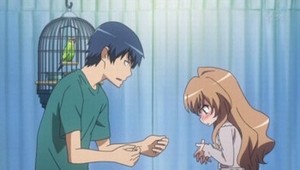
Rating: 3 (of 5)
Review:
Like most school shows, Toradora! begins in typical fashion, as typical student Ryuuji Takasu begins a typical second year where he meets up with his typical friends. But here's where it gets atypical: Ryuuji happens to have inherited his delinquent (and deceased) father's angry eyes, which causes people to run from him in fear. Strange and amusing enough yet? Consider, then, when Ryuuji runs into Taiga Aisaka, a tiny girl with a massive attitude who lives life her own way. When the two of them accidentally discover each other's secret crushes, they enter a very unlikely partnership ...
It's only natural to be skeptical of an anime like this—after all, don't they release like 43 different series every season where "some guy meets some girl"? But Toradora! looks like it could live or die on the strength of its characters, and when they're strong, they are an absolute delight: Taiga raging after Ryuuji with a wooden sword (in the middle of the night, no less); Ryuuji with his often cynical and deadpan one-liners; and the sheer electrochemistry of their clashing personalities. On the other hand, this episode does a really ham-handed job of introducing them—Ryuuji gets a snore-tastic slice-of-life-ish first segment, and the arrival of Taiga is basically heralded with HERE'S A WACKY CRAZY MOE GIRL YOU ARE GOING TO LIKE HER AND WORSHIP HER. Only when the two start playing off each other does the episode hit a more natural stride.
Artistically, the design and overall color scheme seem woefully drab—muted colors only serve to remind us how dull "real" school life can be—but dynamic bursts of action (again, Taiga's amazing sword attack) and some highly expressive character animation (has it ever been more enthralling to watch a girl sleep?) show that the staff are putting in the effort when it counts. A pleasant, if sparse, soundtrack also sets the mood.
Although it stumbles a bit in the early scenes, this episode shows a promising pair of lead characters—but as to whether their odd friendship will be brought to its full potential, well, that remains to be seen.
discuss this in the forum (230 posts) |
this article has been modified since it was originally posted; see change history
back to The Fall 2008 Anime Preview Guide
Season Preview Guide homepage / archives